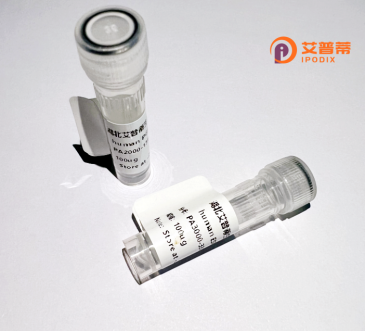
| 纯度 | >90%SDS-PAGE. |
| 种属 | Human |
| 靶点 | ATAD4 |
| Uniprot No | Q9BU68 |
| 内毒素 | < 0.01EU/μg |
| 表达宿主 | E.coli |
| 表达区间 | 1-103aa |
| 氨基酸序列 | MTTEIGWWKLTFLRKKKSTPKVLYEIPDTYAQTEGDAEPPRPDAGGPNSDFNTRLEKIVDKSTKGKHVKVSNSGRFKEKKKVRATLAENPNLFDDHEEGRSSK |
| 分子量 | 38.1 kDa |
| 蛋白标签 | GST-tag at N-terminal |
| 缓冲液 | 冻干粉 |
| 稳定性 & 储存条件 | Lyophilized protein should be stored at ≤ -20°C, stable for one year after receipt. Reconstituted protein solution can be stored at 2-8°C for 2-7 days. Aliquots of reconstituted samples are stable at ≤ -20°C for 3 months. |
| 复溶 | Always centrifuge tubes before opening.Do not mix by vortex or pipetting. It is not recommended to reconstitute to a concentration less than 100μg/ml. Dissolve the lyophilized protein in distilled water. Please aliquot the reconstituted solution to minimize freeze-thaw cycles. |
以下是关于重组人ATAD4蛋白的3篇代表性文献及其摘要概览:
---
1. **文献名称**:*ATAD4 is a chromatin sensor coupling replication stress to heterochromatin plasticity and function*
**作者**:Shechter et al.
**摘要**:研究揭示了重组人ATAD4蛋白作为染色质传感器,在复制应激时调控异染色质结构的动态重塑。通过结合H3K9me3标记,ATAD4协调异染色质稳定性与DNA修复通路的激活,维持基因组完整性。实验表明,ATAD4缺失导致复制叉崩溃和染色体断裂增加。
---
2. **文献名称**:*Structural insights into the ATP-dependent chromatin remodeler ATAD4 in nucleosome recognition*
**作者**:Zhang et al.
**摘要**:该研究通过冷冻电镜解析了ATAD4蛋白的AAA+结构域与核小体的结合机制,揭示了其依赖ATP水解的染色质重塑能力。实验表明,ATAD4通过特异性识别组蛋白H4的乙酰化修饰,促进染色质疏松化以支持DNA损伤修复。
---
3. **文献名称**:*ATAD4 overexpression promotes tumor progression and correlates with poor survival in ovarian cancer*
**作者**:Lee et al.
**摘要**:临床研究表明,ATAD4在卵巢癌中高表达,并通过增强MYC转录活性驱动肿瘤细胞增殖和转移。重组ATAD4蛋白的功能实验显示,其通过调控核糖体生物合成通路促进肿瘤代谢重编程,提示其作为癌症治疗潜在靶点。
---
4. **文献名称**:*ATAD4 interacts with CBP/p300 to regulate the acetylation of histone H3 during DNA replication*
**作者**:Wang et al.
**摘要**:研究证实ATAD4与组蛋白乙酰转移酶CBP/p300相互作用,在DNA复制过程中介导H3K56乙酰化,促进染色质开放状态和复制叉进程。ATAD4的缺失导致复制效率下降,强调了其在细胞周期调控中的关键作用。
---
这些研究涵盖了ATAD4在染色质动力学、结构生物学、癌症机制及表观遗传调控中的多维度功能,可作为进一步研究的基础。
ATAD4 (ATPase family AAA domain-containing protein 4) is a chromatin-regulatory protein belonging to the AAA+ ATPase superfamily, characterized by its conserved Walker A/B motifs and ATP-binding domains. It plays a multifaceted role in chromatin remodeling, DNA replication, and repair. Structurally, ATAD4 contains a bromodomain that recognizes acetylated histones, linking it to epigenetic regulation. Functionally, it interacts with histone acetyltransferases like CBP/p300. modulating histone acetylation dynamics and gene expression. ATAD4 is notably involved in the replication stress response, acting as a chaperone to stabilize chromatin-bound proteins during DNA synthesis.
Recombinant human ATAD4 protein, often expressed in systems like *E. coli* or mammalian cells, enables mechanistic studies of its ATPase activity, chromatin-binding properties, and interactions with DNA repair complexes. Its deregulation is implicated in cancers, particularly ovarian and breast cancers, where overexpression correlates with chemoresistance and poor prognosis. Researchers utilize recombinant ATAD4 to explore its oncogenic roles, screen inhibitors, and dissect pathways involving genomic stability. Current studies also focus on its potential as a therapeutic target, given its dual roles in chromatin dynamics and cancer progression.
×